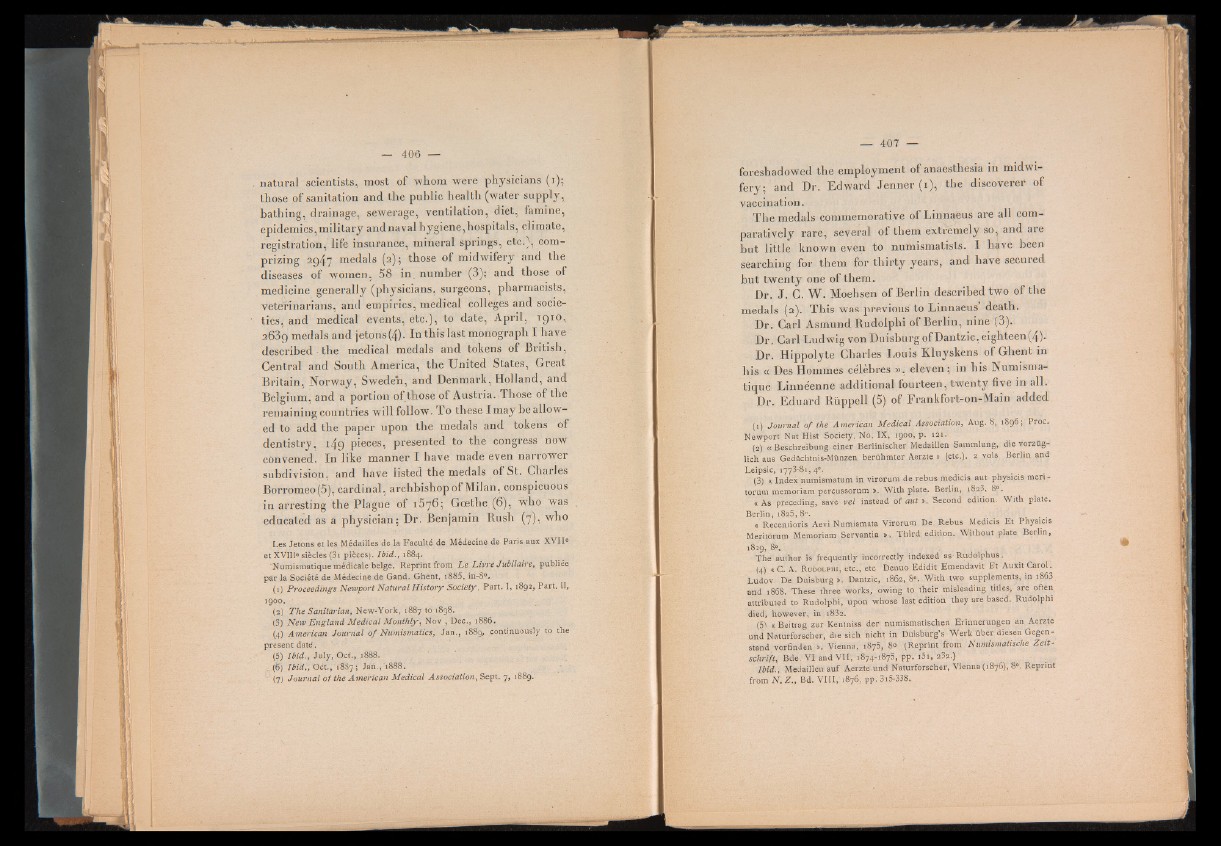
natural scientists, most of whom were physicians (i);
those of sanitation and the public health (water supply,
bathing, drainage, sewerage, ventilation, diet, famine,
epidemics,military andnaval hygiene,hospitals, climate,
registration, life insurance, mineral springs, etc.), comprizing
2947 medals (2); those of midwifery and the
diseases of women, 58 in number (3); and those of
medicine generally (physicians, surgeons, pharmacists,
veterinarians, and empirics, medical colleges and societies,
and medical events, etc.), to date, April, 1910,
2639 medals and jetons (4). In this last monograph I have
described ■ the medical medals and tokens of British,
Central and South America, the United States, Great
Britain, Norway, Sweden, and Denmark, Holland, and
Belgium, and a portion of those of Austria. Those of the
remaining countries will follow. To these Imay be allowed
to add the paper upon the medals and tokens of
dentistry, 149 pieces, presented to the congress now
convened. In like manner I have made even narrower
subdivision, and have listed the medals of St. Charles
Borromeo(5), cardinal, archbishop of Milan, conspicuous
in arresting the Plague of 1576; Goethe (6), who was
educated as a physician; Dr. Benjamin Rush (7), who
Les Jetons et les Médailles de la Faculté de Médecine de Paris aux XVIIs
et XVIIIe siècles (3 i pièces). Ibid., 1884.
'Numismatique médicale belge. Reprint from Le Livre Jubilaire, publiée
par la Société de Médecine de Gand. Ghent, i 885, in-8°.
(1) Proceedings Newport N atural H is to r y S o c ie ty , Part. I, 1892, Part. II,
1900.
(2) The Sanitarian, New-York, 1887 to 1898.
(3) New E ngland Medical Monthly, Nov , Dec., 1886.
(4) American Journal o f Numismatics, Jan., 1889, continuously to the
present daté.
(5) Ibid., July, Oct., 1888.
Ibid., Oct., 18S7; Jan., 1888.
T (7) Journal of the American Medical Association, Sept. 7, 1889.
foreshadowed the employment of anaesthesia in midwi-
fery; and Dr. Edward Jenner (i), the discoverer of
vaccinati on.
The medals commemorati ve of Linnaeus are all comparatively
rare, several of them extremely so, and are
but little known even to numismatists. I have been
searching for them for thirty years, and have secured
hut twenty one of them.
Dr. J. C. W. Moehsen of Berlin described two of the
medals (2). This was previous to Linnaeus’ death.
Dr. Carl Asmund Rudolphi of Berlin, nine (3).
Dr. Carl Ludwig von Duisburg of Dantzic, eighteen(4).
Dr. Hippolyte Charles I.ouis Kluyskens of Ghent in
his « Des Hommes célèbres », eleven; in bis Numismatique
Linnéenne additional fourteen, twenty five in all.
Dr. Eduard Rüppell (5) of Frankfort-on-Main added
(1) Journal o f the American Medical Association, Aug. 8, 1896; Proc.
Newport Nat Hist Society, No. IX, 1900, p. 121.
(2) « Beschreibung einer Berlinischer Medaillen Sammlung, die vorzüglich
aus Gedächtnis-Münzen berühmter Aerzte » (etc.). 2 vols Berlin and
Leipsic, 1773-81,4°.
(3) « Index numismatum in virorum de rebus medicis aut physicis meri-
torum memoriam percussorum ». With plate. Berlin, 1820, b°.
« As preceding, save vel instead o f aut Second edition. With plate.
Berlin, 1825, 8°.
« Receniioris Aevi Numismata Virorum De Rebus Medicis Et Physicis
Meritorum Memoriam Servantia ». Third edition. Without plate Berlin,
1829, 8°.
The author is frequently incorrectly indexed as Rudolphus.
(4 ) « C. A . R u d o l p h i , etc., etc Denuo Edidit Emendavit Et Auxit Carol.
Ludov. De Duisburg ». Dantzic, 1862, 8°. With two supplement?, in i860
and 1868. These three works, owing to their misleading titles* are often
attributed to Rudolphi, upon whose last edition they are based. Rudolphi
died, however, in i 832.
(51 « Beitrag zur Kentniss der numismatischen Erinnerungen in Aerzte
und Naturforscher, die sich nicht in Duisburg’s Werk über diesen Gegenstand
vorfinden ».• Vienna, 1870, 8«. (Reprint from Numismatische Z e itschrift,
Bde. VI and VII, 1874-1875, pp. 1-5i, 232.) -
Ibid., Medaillen auf Aerzte.und Naturforscher, Vienna (1876), 8°. Reprint
. from N , Z ., Bd. VIII, 1876, pp. 3 i 5-338.